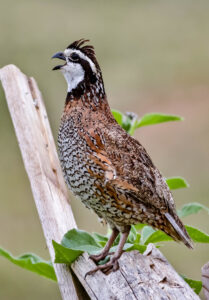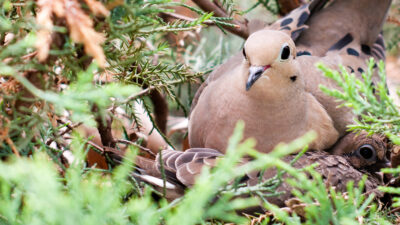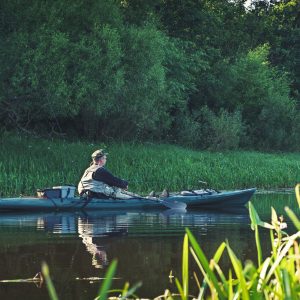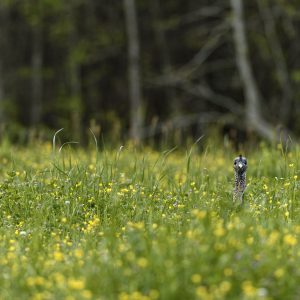The Easter Red Cedar
Our German shorthair pointers were locked up beside a lone cedar tree in the middle of a large West-Kansas field. Just as we were approaching the tree I was anticipating dropping at least one bird, when fifteen birds roared out the opposite side of the tree skillfully keeping the tree between themselves and our guns. Less than 50 years ago it’s a good bet those quail would not have had the advantage of hiding by a cedar tree. That’s because cedars are rapidly expanding into many parts of the country where they were previously not seen.
While it sounds like that covey of quail had gained an advantage because of the cedar, that’s not the case. Looking across much of the country, cedar may be one of the reasons quail and other grassland birds are declining across much of the Great Plains. Fifty to sixty years earlier the primary shrubs across the Great Plains were sumac or sandhill plum. Eastern red cedar (cedar) is a native juniper that extends from Quebec, south to the Gulf of Mexico. Historically, this native tree extended west into the Great Plains but was restricted to deep gullies and rocky bluffs where it was protected from the continuous fires that frequented the prairie.
Over the Great Plains and in the eastern portion of the U.S., cedar was relatively rare before settlement. Native Americans routinely burned much of the country which kept cedar in check. Cedar did have the advantage of occupying rocky bluffs and areas with thin soils. The thin soil restricted grass and it was the lack of grass that slowed or restricted intense fires. Because the fire would carry through a site every few years, cedar was kept in check. As settlement increased, fire was restricted resulting in an increase in cedar in areas where it had not grown before.
One area with cedar that had been protected for long periods of time was in Boone County, Missouri. On this and other sites in the Ozarks, cedars are among some of the oldest trees east of the Rockies. Several located in Missouri have been determined to be over 400 years old!
In addition to protection from fire, cedar planting increased in the late 1800s and early 1900s as farmers established shelter belts around fields. As cedars were planted around fields and homeplaces, these cedars acted as additional seed sources.
The rate of invasion across the prairies is almost occurring at an exponential rate. Oklahoma is a good example, where the problem has been monitored for the past several decades. In 1950 there were 1.5 million acres of cedar in the state, by 1985 this number had increased to 3.5 million acres and in 2002 there were 8 million acres with 50 cedars per acre. This is now estimated at an increase of 762 acres per day!
A common belief is cedar berries will not germinate unless it passes through the digestive tract of a bird. Look down any fencerow and it’s easy to believe because it appears everywhere a bird sits you will see small cedars sprouting. Seeds can germinate without the aid of birds, but germination is improved by birds consuming and passing the berry through its digestive tract. After being consumed, the seed is scarified, greatly improving germination.
Two species of birds noted for eating the blue cedar berries are the cedar waxwing and robin. During migration, these berries are a staple for these two species. Researchers observed a single robin consuming up to 500 berries per day. In addition to birds, numerous mammals including fox, raccoon, and deer will consume cedar berries.
It seems problematic for deer when they consume large amounts of cedar berries because it generally indicates poor habitat conditions, plus the blue cedar berries trigger lowered rumen activity. Both cause temporary weight reduction in the deer. From the standpoint of food, red cedar should not be confused with northern white cedar which deer consume readily. Overall, eastern red cedar is a poor-quality food for deer. If cedar shows up in deer food studies, it remains low on the list, generally only comprising 2-3% of the winter diet.
Steven Smith, Wildlife and Fisheries Consultant at the Noble Research Institute said, “There are some pros for cedar, first it makes excellent thermal and escape cover, plus over 71 species use cedar at some point in their life cycle, either for nesting, hiding cover, or food, not to mention it makes good fence posts.” Many livestock farmers like cedar for windbreaks and research shows that homeowners may see a 10 to 40% reduction in energy costs with cedar windbreaks.

Depending on your location, and local conditions, cedar can be short, scrubby, and twisted or large, stately trees. One of the best points for the cedar is providing excellent thermal cover for deer, numerous birds and it’s a favorite nest site for morning doves. In the southern portion of the ruffed grouse range such as Missouri, grouse use cedar for winter cover. Throughout the northern range of ruffed grouse, they roost in the snow. This helps reduce their metabolic rate because the snow acts as an insulator. On the southern portion of the ruffed grouse range, snow is either not present or deep enough for grouse to roost in. Wildlife biologists in Missouri determined that grouse roosting in cedars was able to retain energy during severe weather.
While cedar can provide good thermal cover for deer, large expanses of cedar may lose their appeal to deer. I have found that in a normal mix of hardwoods, fields, and other cover, cedar thickets in the one to two-acre range appear to get the greatest use during winter. No doubt deer welcome cedar as thermal cover during severe weather but it seems they hang out along the edges of larger cedar stands.
Under cedar trees, heavy rain is blocked, snow is restricted, but dense cedar thickets restrict sunlight to the point that little herbaceous vegetation grows. Cedar can also secrete toxins into soil that restrict many plants deer utilize for food. Many plants exhibit this trait called allelopathy. Besides the Junipers, another allelopathic plant is the black walnut. This is one reason deer are forced to move in and out of thickets to feed. It is also why smaller cedar thickets may hold more deer than larger thickets. Cedar is a pioneer plant or generally the first tree to move onto a site which is why it can grow on poor soils. Overtime, cedars will build up organic matter allowing hardwoods to eventually move it. Look a site over before making a conversion and keep this in mind before starting any cutting.

Another interesting fact about cedar, because it is an evergreen it is capable of growing year-round. When the soil freezes and temperatures are well below freezing cedars will shut down which is what happens in the northern latitudes. In the south, year-round growth is possible. This gives cedar a real advantage over hardwoods. Anytime temperatures get above 40 F some growth can occur which allows cedars to compete in hardwood forests sometimes forming a dense under valuable hardwood species. This restricts their growth and mast production. Smith said, “Remember, cedar is a native tree, it has its place, but you must manage it and the best way to do this is with prescribed burning.”
In many locations fire may not control cedar. When this occurs, you must use either mechanical or chemical methods. Smith said, “When clearing cedar, the question is always “how much do I cut? In this case start with 50%, step back and evaluate.”
Controlling cedar is easy if they are less than 3-4 feet tall, however, the taller they are the more difficult the job. In large cedar thickets I have cut trees down into the stand to help fire climb into the crowns, but this is a burning job that should be reviewed carefully by someone with extensive prescribed fire experience. In many locations such as Kentucky, Tennessee, or Missouri there is a market for cedar lumber and these markets can help cut back large cedar thickets if trees are large enough. In the past, we have had cedar sawed into 4X4 and 6X6 lumber for constructing buildings around the farm or hunting camps including sheds deer blinds, feeder stands, and fence posts. The red center of cedar lumber is very durable.
Steve Smith said, “One thing cedar is noted for is using lots of water, but more importantly cedar intercepts water.” It generally must rain more than 0.10 inches before the first drop makes it to the ground. In parts of the country where rain is scarce cedar can quickly change the plant composition. Even if the tree is completely saturated a large part of the moisture may evaporate before it falls off the tree. In the east where rainfall is sufficient, this may not be an issue, but on the Great Plains, this can have disastrous effects on grass production.
Mossy Oak Nursery Manager, Dudley Phelps, said, “Whether you think cedar is good or bad depends on where you are.” They are great for blocking views along roads.” If you are using cedar for breaks or blocking views, consider adding some organic liquids to boost growth. Shrub lines are good places to keep cedar where they can be controlled. Phelps added, “Where cedar is controlled they are useful for shrub lines especially if the site has poor soil.”

John Weir, Research Associate at Oklahoma State University said it looks like a lot of cedar plantings are beginning to slow down. Oklahoma is working to get production stopped because cedar has spread so rapidly. “The further north you go the slower the invasion. This invasion is now trying to be stopped up in the Dakotas and they are trying to get a handle on it. Nebraska has been working on the invasion for the past 15 years.” One rancher up in Nebraska told Weir, “When I was a kid I hauled water on horseback to water cedars along our shelterbelts and now I’m killing and burning it.”
The spread is rapidly moving across the prairie with the aid of birds and mammals that eat and deposit the seeds. The “Ugly” part about cedars is their impact on the prairies. Weir said, “Research has shown that as few as four cedar trees per acre will stop grassland birds from using the area.” At this point, researchers are still not sure exactly how this affects the birds, but one thing for sure cedars and prairies do not mix. Weir said, “The decline of so many species of birds on the prairies far outweighs any positives you might believe it has.”
Over the past two decades, where quail were numerous, Oklahoma researchers have seen some of the biggest declines. There are many reasons why this is occurring, but it’s a good bet, the expansion of cedar has not helped. Across prairies, cedar invasion is hurting many of the local species. Another species showing serious declines is the prairie chicken. This large game bird seems to avoid trees most of the year and one researcher stated that prairie chickens, under most circumstances, will avoid sites if trees are present. These grassland birds are declining over much of their range due in part to the expansion of cedars. Prairie habitat is one place use of this tree should be restricted.
One additional word of warning about cedar – if you have it growing near cabins keep the cedar trimmed off buildings, so it will not create a fire hazard. Cedar can “lift” fire onto a building by serving as “ladder fuel.” Across much of the prairie states, cedar is making the fire more dangerous because of longer flame lengths and/ or increased heat making wildland fire fighting more difficult.
Eastern Red cedar is a native species. When kept in its place, cedar can be good for the property, but when out of place or out of control the results are ugly. With eastern red cedar, it’s one tree affected by the location or the situation and no matter how you see cedar, it is the good, the bad, and the ugly of the forest.






